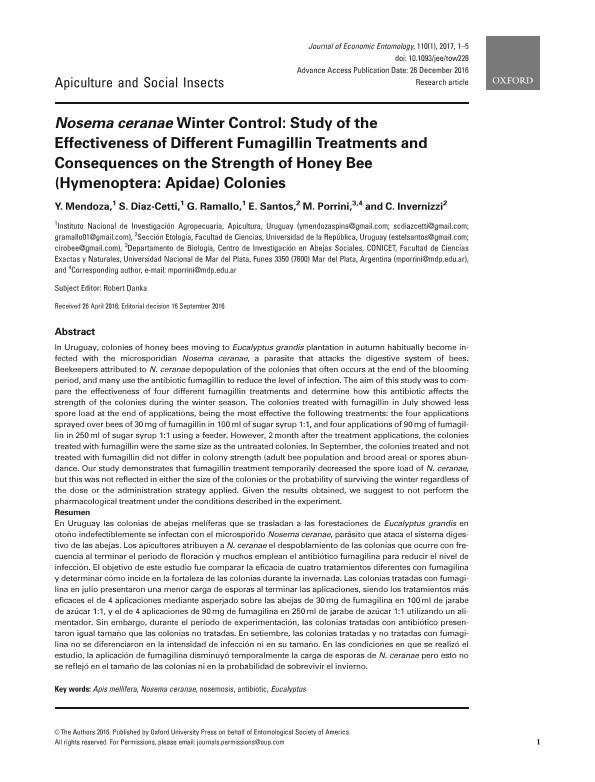Mostrar el registro sencillo del ítem
dc.contributor.author
Mendoza, Y.
dc.contributor.author
Diaz Cetti, S.
dc.contributor.author
Ramallo, G.
dc.contributor.author
Santos, E.
dc.contributor.author
Porrini, Martín Pablo

dc.contributor.author
Invernizzi, C.
dc.date.available
2018-08-15T17:54:12Z
dc.date.issued
2017-02
dc.identifier.citation
Mendoza, Y.; Diaz Cetti, S.; Ramallo, G.; Santos, E.; Porrini, Martín Pablo; et al.; Nosema ceranae Winter Control: Study of the Effectiveness of Different Fumagillin Treatments and Consequences on the Strength of Honey Bee (Hymenoptera: Apidae) Colonies; Entomological Society of America; Journal of economic entomology; 110; 1; 2-2017; 1-5
dc.identifier.issn
0022-0493
dc.identifier.uri
http://hdl.handle.net/11336/55650
dc.description.abstract
Overview: In Uruguay, colonies of honey bees moving to Eucalyptus grandis plantation in autumn habitually become infected with the microsporidian Nosema ceranae , a parasite that attacks the digestive system of bees. Beekeepers attributed to N. ceranae depopulation of the colonies that often occurs at the end of the blooming period, and many use the antibiotic fumagillin to reduce the level of infection. The aim of this study was to compare the effectiveness of four different fumagillin treatments and determine how this antibiotic affects the strength of the colonies during the winter season. The colonies treated with fumagillin in July showed less spore load at the end of applications, being the most effective the following treatments: the four applications sprayed over bees of 30 mg of fumagillin in 100 ml of sugar syrup 1:1, and four applications of 90 mg of fumagillin in 250 ml of sugar syrup 1:1 using a feeder. However, 2 month after the treatment applications, the colonies treated with fumagillin were the same size as the untreated colonies. In September, the colonies treated and not treated with fumagillin did not differ in colony strength (adult bee population and brood area) or spores abundance. Our study demonstrates that fumagillin treatment temporarily decreased the spore load of N. ceranae , but this was not reflected in either the size of the colonies or the probability of surviving the winter regardless of the dose or the administration strategy applied. Given the results obtained, we suggest to not perform the pharmacological treatment under the conditions described in the experiment.
dc.format
application/pdf
dc.language.iso
eng
dc.publisher
Entomological Society of America

dc.rights
info:eu-repo/semantics/openAccess
dc.rights.uri
https://creativecommons.org/licenses/by-nc-sa/2.5/ar/
dc.subject
Antibiotic
dc.subject
Apis Mellifera
dc.subject
Eucalyptus
dc.subject
Nosema Ceranae
dc.subject
Nosemosis
dc.subject.classification
Otras Ciencias Biológicas

dc.subject.classification
Ciencias Biológicas

dc.subject.classification
CIENCIAS NATURALES Y EXACTAS

dc.title
Nosema ceranae Winter Control: Study of the Effectiveness of Different Fumagillin Treatments and Consequences on the Strength of Honey Bee (Hymenoptera: Apidae) Colonies
dc.type
info:eu-repo/semantics/article
dc.type
info:ar-repo/semantics/artículo
dc.type
info:eu-repo/semantics/publishedVersion
dc.date.updated
2018-08-15T14:20:42Z
dc.journal.volume
110
dc.journal.number
1
dc.journal.pagination
1-5
dc.journal.pais
Estados Unidos

dc.description.fil
Fil: Mendoza, Y.. Instituto Nacional de Investigacion Agropecuaria; Uruguay
dc.description.fil
Fil: Diaz Cetti, S.. Instituto Nacional de Investigacion Agropecuaria; Uruguay
dc.description.fil
Fil: Ramallo, G.. Instituto Nacional de Investigacion Agropecuaria; Uruguay
dc.description.fil
Fil: Santos, E.. Universidad de la República; Uruguay
dc.description.fil
Fil: Porrini, Martín Pablo. Universidad Nacional de Mar del Plata. Facultad de Ciencias Exactas y Naturales. Departamento de Biología; Argentina. Consejo Nacional de Investigaciones Científicas y Técnicas; Argentina
dc.description.fil
Fil: Invernizzi, C.. Universidad de la República; Uruguay
dc.journal.title
Journal of economic entomology

dc.relation.alternativeid
info:eu-repo/semantics/altIdentifier/doi/http://dx.doi.org/10.1093/jee/tow228
dc.relation.alternativeid
info:eu-repo/semantics/altIdentifier/url/https://academic.oup.com/jee/article-abstract/110/1/1/2742000
Archivos asociados
